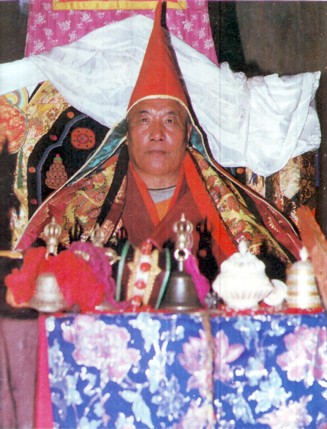Sherab Özer Rinpoche: Difference between revisions
No edit summary |
No edit summary |
||
| Line 1: | Line 1: | ||
[[Image:Sherab Ozer.jpg|frame|'''Sherab Özer Rinpoche''']] | |||
'''Sherab Özer Rinpoche''' was born in 1922 and was recognised as the incarnation of Orgyen Rigdzin Sempa Dorje, the main Dharma heir of the great master [[Nyala Pema Duddul]]. From an early age he studied with many revered masters in East Tibet. | '''Sherab Özer Rinpoche''' was born in 1922 and was recognised as the incarnation of Orgyen Rigdzin Sempa Dorje, the main Dharma heir of the great master [[Nyala Pema Duddul]]. From an early age he studied with many revered masters in East Tibet. | ||
Revision as of 14:19, 24 July 2007

Sherab Özer Rinpoche was born in 1922 and was recognised as the incarnation of Orgyen Rigdzin Sempa Dorje, the main Dharma heir of the great master Nyala Pema Duddul. From an early age he studied with many revered masters in East Tibet.
At twelve, he studied the sutras for three years at Lumo Rab, a monastery which has a very strong connection with the great Mindroling Monastery in Central Tibet. In fact, it was from Minling Khenchen Rinpoche and Minling Chung Rinpoche that he received the name Sherab Özer.
At the age of 21, he went to live in the labrang at Kalsang Gonpa, the seat of Nyala Pema Duddul, which later became the seat of Tertön Sogyal Lerab Lingpa. He received the teachings and profound instructions of Dzogpachenpo from Tulku Dorje Duddul at Dre Tsal Monastery, the empowerments and teachings for Nyala Pema Duddul’s revelation Zabchö Khakhyab Rangdrol from Jazi Anyé Tulku, and studied and practised with masters of the Sakya, Gelug and Nyingma schools.
In 1949, Sherab Özer Rinpoche was asked by Chinese government to help in local affairs, and later, during the Cultural Revolution, he passed through many difficulties. In 1981, he visited a number of different monasteries, as a result of which he set up, in Sichuan province, thirty four “Cultural Heritage Protection Associations”. In 1984, Rinpoche founded the Sichuan Province Tibetan Buddhist Institute.